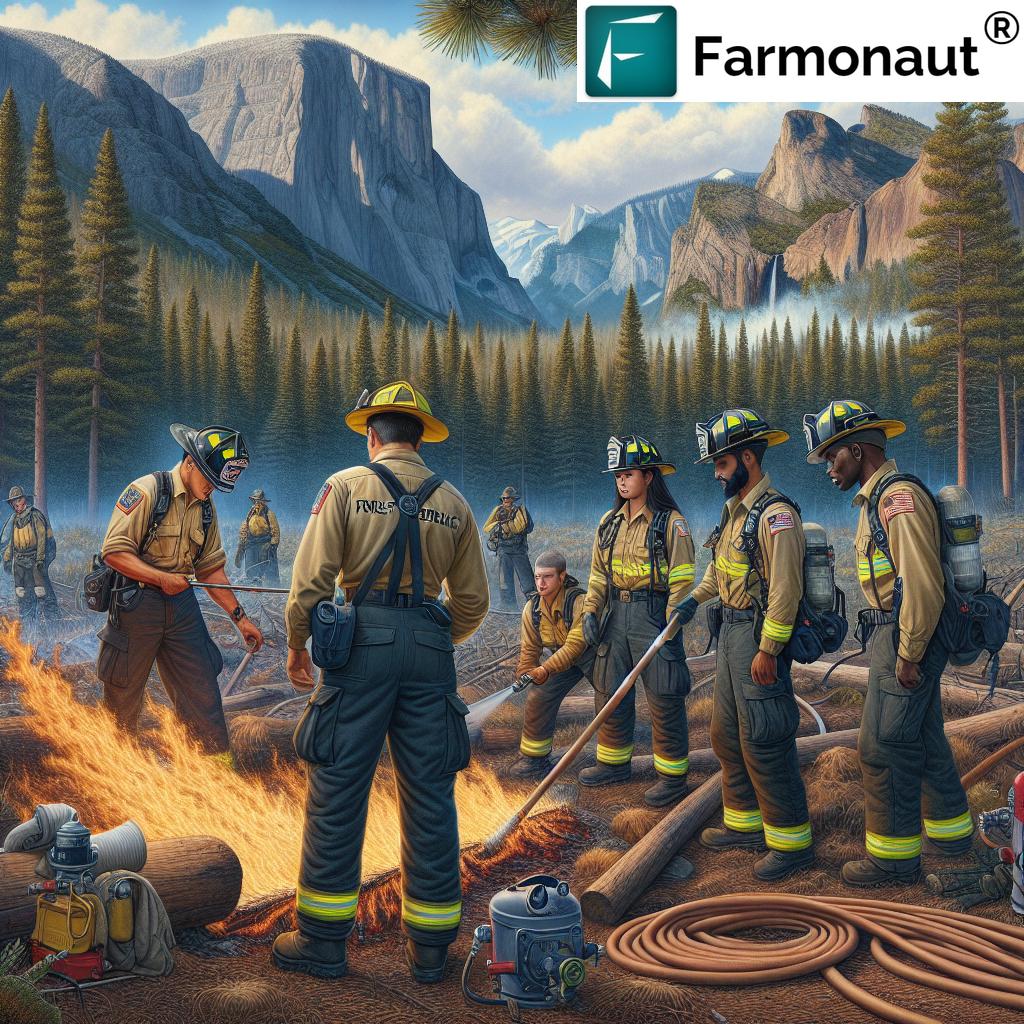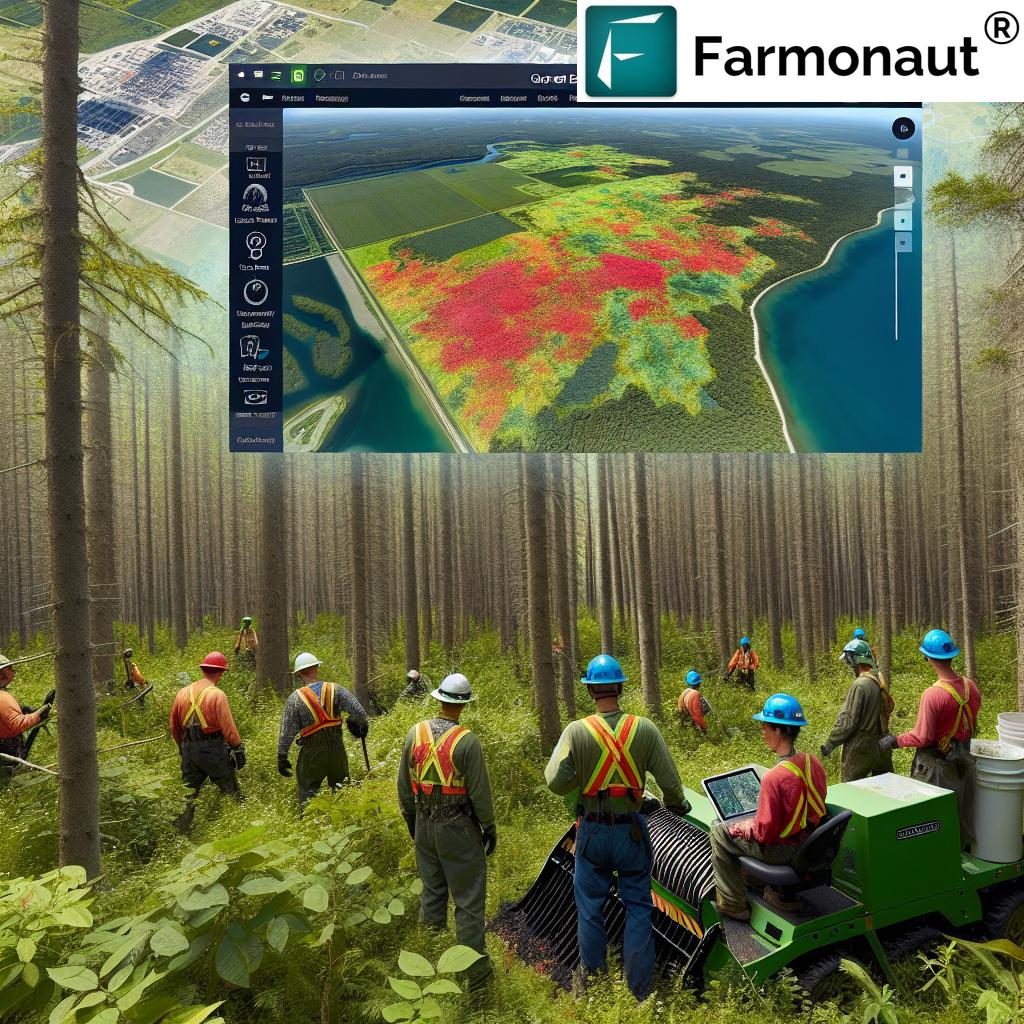Table of Contents
- Fast Facts: Wildland Firefighter Hiring Trends
- Introduction: Massive Wildland Firefighter Jobs Open in the Rocky Mountain Region
- Overview: Wildland Firefighter Jobs, Permanent Careers, and Support Staff Roles
- Detailed Positions and Career Paths in the Rocky Mountain Region
- Requirements, Eligibility, and How to Apply Online
- Wildland Firefighter Job Opportunities by State and Position (Table)
- Key Benefits, Challenges, and Why These Roles Matter
- Forest Fire Prevention, Fire Management Careers, and Modern Tech Integration
- The Impact of Satellite and AI in Fire Prevention & Agriculture
- Farmonaut: Advanced Solutions Empowering Fire and Forest Management
- Fire Management: Key Hiring Trends and Permanent Roles
- Apps & APIs for Modern Resource and Fleet Management
- Farmonaut Subscription Options
- FAQs: Wildland Firefighter Jobs & Careers
- Conclusion and Further Resources
1,100 Wildland Firefighter Jobs Open in the Rocky Mountain Region: Your Guide to Fire, Forest, and Management Careers
RAPID CITY, S.D. (KOTA) – The U.S. Forest Service has just announced an urgent, game-changing opportunity: over 1,100 wildland firefighter jobs, permanent fire management careers, and fire support staff hiring across the Rocky Mountain region. Whether you are seeking an adventurous firefighting job or aiming for a long-term federal career within the nation’s forests and grasslands, this recruitment wave covers a broad spectrum—from seasonal crew to permanent fire specialists, aviation officers, engine operators, dispatchers, and support staff positions.
The 2025 fire year brings with it increased urgency in Colorado, Kansas, Nebraska, South Dakota, and Wyoming. With large-scale wildfires posing mounting risks to our landscapes and communities, the government agency is investing heavily in new personnel to bolster fire prevention initiatives and implement active forest management strategies. If you’re 18 or older and a U.S. citizen or national, you may be eligible to apply and help make a difference this wildfire season.
In this post, we explore:
- The range of wildland firefighter jobs and support staff positions newly opened
- What these careers involve and the variety of roles available
- Application steps, eligibility requirements, and official resources
- Latest trends in fire management careers and the future of forest fire prevention positions
- How innovative solutions like Farmonaut are reshaping modern fire and resource management
Let’s dive in and uncover how you can be part of the crucial efforts to protect our natural resources and communities in the Rocky Mountain region.
Wildland Firefighter Jobs and Fire Management Careers: An Overview
As the climate shifts and wildfire risks escalate, wildland firefighter jobs are more essential—and diverse—than ever.
This year, the U.S. Forest Service is hiring approximately 1,100 permanent firefighters and support staff throughout the Rocky Mountain region—spanning major territories such as Colorado, Kansas, Nebraska, South Dakota, and Wyoming. These positions open the door to a wide range of career profiles, not only in direct fire suppression but also in aviation, planning, engineering, and prevention:
- Frontline firefighting crew members tackling wildfires on the ground
- Helitack and hotshot teams providing high-intensity, rapid response
- Aviation officers and pilots leading air operations
- Fire engine operators and equipment specialists
- Dispatchers and fire management officers orchestrating fire operations
- Fire planners, prevention specialists, fuels specialists for strategic management
- Support staff (from logistics to communications)
This comprehensive hiring drive signals a major trend: permanent firefighter positions and forest fire prevention positions are expanding significantly to build resilience against catastrophic wildfires.
A Detailed Look at Firefighting Jobs in the Rocky Mountain Region
Breakdown of Roles: Wildland Firefighter Jobs, Aviation, Management & More
The firefighting jobs in the Rocky Mountain region offer distinct tracks based on interests, skills, and career ambitions. Let’s break down the vast landscape of positions available:
1. Wildland Firefighters and Crew Members
- Hand-crew Members: Forming the backbone for ground-based wildfire combat, constructing firelines, clearing debris, or directly attacking blazes
- Hotshot Crew Members: Elite, highly-trained teams sent into the most dangerous wildfire zones
- Helitack Crew Members: Specialized responders deploying to fires via helicopter
- Smokejumpers: Parachuting directly into remote fire locations to establish first response lines
2. Fire Management Officers, Planners, and Specialist Roles
- Fire Management Officers (FMOs): Lead fire operations, coordinate multi-agency responses, and develop suppression strategies
- Fire Planners: Develop policies for prescribed burns and long-term landscape resilience
- Fire Prevention Specialists: Engage in outreach, community risk reduction, and inspection programs
- Prescribed Fire and Fuels Specialists: Carry out controlled burns to mitigate wildfire intensity by reducing available fuels
3. Aviation Officer Positions in Fire Service
- Aviation Officers: Plan and supervise aerial firefighting operations, from water drops to mapping and crew transport missions
- Pilots: Operate fixed-wing aircraft or helicopters for suppression, reconnaissance, or crew movements
4. Fire Equipment Operator Jobs & Technical Support
- Fire Engine Operators: Drive and operate specialized firefighting vehicles and pumps
- Equipment Operators: Use heavy machinery (e.g., bulldozers, water tenders) to create defensible fire lines and access roads
- Forestry Aids and Technicians: Support both on-site response and long-term forest resilience planning
5. Dispatch, Logistics, and Support Staff Hiring
- Dispatchers: Coordinate communication and resource movement for ongoing wildfires and emergency response
- Logistics, Communications, and Other Support Staff: Ensure smooth operations and crew safety
Each pathway addresses key aspects of the wildfire response ecosystem—and all of them are integral to the success of the Rocky Mountain region’s comprehensive fire and forest management strategies. These opportunities represent exciting and impactful fire management careers for those seeking both adventure and public service.
Requirements: Who Can Apply for Wildland Firefighter and Fire Management Jobs
Eligibility & Key Details for Applicants
- Applicants must be at least 18 years of age at the time of appointment
- Open to all U.S. citizens and nationals
- Relevant experience or education (varies by position): see the Forest Service Careers Webpage for position-specific requirements
- Physical fitness: Many roles require fitness screening due to the rigorous work environment
- Commitment to ethical public service and forest stewardship
These jobs span both entry-level and experienced fire professionals, with several pathways to permanent firefighter positions in the Rocky Mountain region.
How to Apply for Firefighter Jobs Online
- Visit the official Forest Service Careers Webpage.
- Search for firefighter, management, or support staff roles in Colorado, Kansas, Nebraska, South Dakota, or Wyoming.
- Apply through USAJobs.gov by the deadline—Thursday, April 24, 2025.
- Review job descriptions, minimum qualifications, and required documents (e.g., resumes, certifications).
- Submit your application and stand by for interview notices or further instructions.
Applications are competitive—being prompt and thorough increases your chance of success.
Wildland Firefighter Job Opportunities by State and Position
Below is a quick-reference table for firefighting job opportunities in key Rocky Mountain states:
| State | Estimated Openings | Job Type | Application Deadline | How to Apply |
|---|---|---|---|---|
| Colorado | 375 | Wildland Firefighters, Permanent Fire Management, Support Staff | April 24, 2025 | Apply Online (USAJobs) |
| Wyoming | 210 | Engine Operators, Aviation, Hotshot, Dispatchers | April 24, 2025 | Apply Online (USAJobs) |
| Montana | 200 | Support Staff, Fire Planners, Prevention Specialists | April 24, 2025 | Apply Online (USAJobs) |
| South Dakota | 140 | Handcrew, Smokejumpers, Forestry Technicians | April 24, 2025 | Apply Online (USAJobs) |
| Nebraska | 100 | Equipment Operators, Dispatch, Fuels Specialists | April 24, 2025 | Apply Online (USAJobs) |
| Kansas | 75 | Forestry Aids, Support Staff, Dispatchers | April 24, 2025 | Apply Online (USAJobs) |
Note: Estimated numbers based on historical hiring averages and recent announcements; check the Forest Service Careers webpage for real-time listings and updates.
Why Pursue a Career in Wildland Firefighting or Fire Management?
Key Benefits
- Job stability: Many roles are now permanent, offering growing career paths in government service
- High impact: Help protect lives, property, and vital ecosystems in the Rocky Mountain region
- Dynamic work environment: Work in a variety of forests, grasslands, and national park landscapes
- Specialized training: Acquire skills in fire behavior, aviation, engine operations, forestry and emergency management
- Competitive compensation & benefits (health, retirement, paid leave, federal job security)
- Community service: Play a crucial part in safeguarding our region’s future against wildfires
Potential Challenges
- Physical demands: Many jobs require long shifts, physical endurance, and exposure to challenging terrain and weather
- Risk: High-stress emergencies and unpredictable wildfire behavior
- Seasonal peak workloads: Intense work periods during wildfire season
However, with modern training, improved support structures, and innovative planning, these roles offer personally and professionally rewarding outcomes.
Modern Fire Prevention & Fire Management Careers: Trends and Technologies
The Future of Forest Fire Prevention Positions
Today’s forest fire prevention positions go far beyond traditional firefighting. Prevention specialists and fuels managers use state-of-the-art science and remote data to:
- Identify areas at highest risk using climate, weather, and vegetative conditions
- Plan and execute prescribed burns that reduce hazardous fuels
- Cultivate resilient landscapes and communities around the Rocky Mountain region
The rise of geospatial analytics, satellite imagery, and AI-driven planning means that fire management careers are now at the nexus of boots-on-the-ground action and advanced technology.
The ability to remotely monitor, model, and manage forest resources is critical for robust national forest job openings and for ensuring long-term fire preparedness.
The Power of AI, Satellite Data, and Traceability in Fire & Forest Management
Companies like Farmonaut provide cutting-edge tools for landscape resilience, fuel load analysis, and logistics. While these technologies primarily serve agriculture, the principles of precision resource management and remote monitoring are directly relevant to modern fire prevention and forest service careers. Integrating satellite sensing and data-driven insights allows agencies to implement highly effective forest and fire strategies.
Farmonaut’s solutions help:
- Monitor crop and vegetative health using multispectral satellite-based crop health monitoring—useful for assessing post-fire regrowth and fuel risks
- Deploy AI-based advisory systems for weather and risk analytics
- Utilize blockchain for product traceability—relevant for supply chain transparency, including sustainable timber or recovered resources following wildfires
- Manage fleets and machinery through fleet management tools, ensuring safe, efficient operations across vast, rugged terrain
- Track environmental impact with carbon footprinting to measure the sustainability of fire prevention and forest restoration strategies
Farmonaut’s modular approach enables government agencies and agribusinesses to manage large-scale forests and grasslands using satellite data and AI insights—helping frontline fire planners and forestry management officers make informed, impactful decisions.
Apps & APIs: Mobilizing Modern Fire, Forest & Fleet Management
Managing large-scale fire, forest, and resource operations in the Rocky Mountain region demands seamless, mobile platforms. Farmonaut addresses this with:
- Android & iOS apps, web and browser access for real-time forest and crop health updates, resource tracking, and support staff communications
- Open API access and developer documentation for custom integrations—vital for local governments, forestry agencies, and disaster response systems
For those managing fire equipment fleets or agricultural vehicles across the Rocky Mountain region, Farmonaut’s fleet and resource management delivers:
- Simplified deployment and tracking of resources (vehicles, bulldozers, engines)
- Reduced operational costs and improved personnel safety
- Comprehensive, scalable tools for small teams and large public agencies alike
Farmonaut Subscription Options for Resource & Fire Management Teams
Thinking of equipping your crew, department, or government agency with advanced crop, forest, and fleet monitoring?
Explore Farmonaut’s flexible subscription models—accessible via the web, Android, or iOS apps, with scalable pricing based on area monitored and feature set:
Farmonaut offers powerful, affordable precision tools for everyone from individual farmers to large government teams in the Rocky Mountain region and beyond. Learn about satellite-based crop loan and insurance verification — a model relevant for fire recovery agriculture and risk management financing.
Frequently Asked Questions: Wildland Firefighter Jobs & Forest Management Careers
1. What types of wildland firefighter jobs are available in the Rocky Mountain region?
Roles include wildland firefighter crew members, hotshot and helitack teams, engine operators, aviation officers and pilots, dispatchers, fire management officers, fire prevention and fuels specialists, forestry aids & technicians, smokejumpers, and support staff positions.
2. Who can apply for these government firefighter jobs?
Any U.S. citizen or national who is at least 18 years of age can apply. Some roles require relevant experience or specific educational backgrounds; all require physical fitness and commitment to public service.
3. How do I apply for fire management or support staff positions?
Applications for wildland fire, forest, and support staff jobs are accepted through the U.S. Forest Service’s Careers webpage and officially submitted via USAJobs.gov. Search for roles by location, position type, and your own interests/qualifications.
4. What does the hiring process look like?
You’ll need to submit a thorough application (including your resume and documents); some jobs require fitness tests, interviews, and/or certifications. Review deadlines and instructions carefully on the job portal.
5. What are the prospects for permanent fire management careers in the Rocky Mountain region?
The U.S. Forest Service is increasing its permanent workforce, especially in the Rocky Mountain region, due to the growing risk and frequency of wildfires. Many support staff, specialized, and leadership roles also provide pathways to federal career advancement.
6. Can advanced technology help fire and forest management?
Yes, tools like Farmonaut provide satellite-based data, AI insight platforms, blockchain traceability, and fleet management, aiding both proactive prevention and efficient resource deployment in forested and agricultural landscapes.
7. Where can I find resources for sustainable post-fire recovery and environmental compliance?
Check out Farmonaut’s carbon footprinting module, which enables robust sustainability tracking ensuring your organization meets both regulatory and environmental goals during reforestation and fire recovery.
Conclusion: Start Your Career in Wildland Firefighting and Explore the Smart Future of Forest Management
The call for wildland firefighter jobs, fire management careers, and support staff hiring in the Rocky Mountain region reflects the urgent demand for skilled, committed personnel who can safeguard both people and ecosystems against the rising threat of wildfires. From permanent field and aviation roles to technical support and logistics, there’s a crucial job—and an important mission—for everyone who wants to serve in Colorado, Wyoming, Montana, South Dakota, Nebraska, and Kansas.
As active or aspiring fire professionals, we now have access to a new generation of precision tools, intelligent platforms, and real-time data systems. Solutions from leaders like Farmonaut are making it easier to implement effective fire prevention strategies, streamline fleet logistics, and monitor environmental impacts—all crucial in the era of dynamic, tech-driven fire and forest management.
Ready to take the next step? Explore:
- Current job openings: Forest Service Careers Webpage
- Application submissions: USAJobs Portal
- Data-driven fleet, environmental, and farm management tools: Farmonaut Website
Stay informed, stay proactive, and be part of the change in the Rocky Mountain region’s fight against wildfire. For tech-savvy teams, download the Farmonaut App and explore API integration options today.
For more information on scalable forest, crop, and resource management—visit the official Farmonaut platform access page today.
Empower your future. Protect our landscapes. Shape a safer, greener tomorrow—one fire season, one forest, one innovation at a time.






















